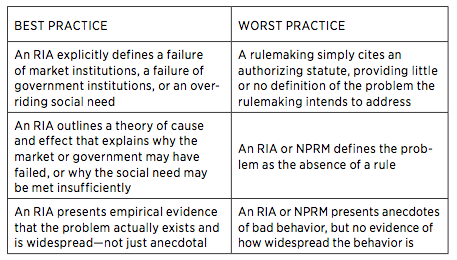For nearly four decades, presidential administrations have required executive branch regulatory agencies to identify the problem they are trying to address and assess its significance, examine a wide range of alternative solutions, estimate the costs and benefits of the alternatives, and regulate only when the benefits justify the costs. In 1993, President Clinton’s Executive Order 12866 laid out the fundamental requirements that have governed regulatory analysis and review ever since. In January 2011, President Obama’s Executive Order 13563 reaffirmed the principles and processes articulated in the Clinton executive order:
For nearly four decades, presidential administrations have required executive branch regulatory agencies to identify the problem they are trying to address and assess its significance, examine a wide range of alternative solutions, estimate the costs and benefits of the alternatives, and regulate only when the benefits justify the costs. In 1993, President Clinton’s Executive Order 12866 laid out the fundamental requirements that have governed regulatory analysis and review ever since.1 In January 2011, President Obama’s Executive Order 13563 reaffirmed the principles and processes articulated in the Clinton executive order:
Our regulatory system must protect public health, welfare, safety, and our environment while promoting economic growth, innovation, competitiveness, and job creation. It must be based on the best available science. It must allow for public participation and an open exchange of ideas. It must promote predictability and reduce uncertainty. It must identify and use the best, most innovative, and least burdensome tools for achieving regulatory ends. It must take into account benefits and costs, both quantitative and qualitative. It must ensure that regulations are accessible, consistent, written in plain language, and easy to understand. It must measure, and seek to improve, the actual results of regulatory requirements.2
Regulations, regulatory impact analyses (RIAs), and notices of proposed rulemaking (NPRMs) that reflect the following 10 principles have the best chance of accomplishing these goals. Regulatory agencies are permitted to follow these principles only to the extent that they do not conflict with the laws the agencies implement, so it would also behoove Congress to keep these principles in mind when it writes regulatory legislation.
1. Since regulations impose constraints that govern people’s behavior, a sensible regulation should solve a real, widespread problem that could reasonably be addressed by altering constraints. It should not just respond to anecdotes of bad behavior by bad actors.
- The very first principle enunciated in Executive Order 12866 is that “each agency shall identify the problem that it intends to address (including, where applicable, the failures of private markets or public institutions that warrant new regulatory action) as well as assess the significance of that problem.” 3
- It makes sense that this is the first principle. Before regulating, regulators should ascertain whether they are dealing with a systemic problem that regulation could solve. And understanding the nature of the problem is vital to crafting a solution that will actually work.
- Circular A-4, the Office of Management and Budget (OMB) guidance on regulatory analysis for agencies, elaborates further:
If the regulation is designed to correct a significant market failure, you should describe the failure both qualitatively and (where feasible) quantitatively. . . . For other interventions, you should also provide a demonstration of compelling social purpose and the likelihood of effective action. Although intangible rationales do not need to be quantified, the analysis should present and evaluate the strengths and limitations of the relevant arguments for these intangible values.4 - Agencies often fail to adequately identify or thoroughly analyze a systemic problem. The Mercatus Center’s Regulatory Report Card assesses the extent to which agency RIAs comply with the major principles in Executive Order 12866 and Circular A-4.5 Assessment of the systemic problem is the regulatory analysis criterion that earned the lowest score on the Regulatory Report Card in both the Bush and Obama administrations.6



